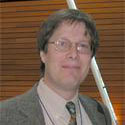CU Chem and Chem Eng History
A History of Chemistry and Chemical Engineering at Cooper Union

Executive summary: The Chemistry department at the Cooper Union was established in 1859 when the Cooper Union first opened its doors. The first "course in Chemistry" was approved as a three-year diploma program in 1881 offfered by the "Cooper Union School of Chemistry" and began in 1883, with its first graduate completing the course of study in 1884.
In 1905, the four-year B.S. in Chemistry was launched as part of the newly established "Day School." The Chemical Engineering degree at Cooper Union was first established in 1924 (replacing the Chemistry degree by 1929), and in 1929 the name of the original Chemistry department was changed to Chemical Engineering.
The faculty of the renamed Chemical Engineering department consisted of both chemical engineers and chemists from 1929 until 1972, at which point the department was administratively divided into separate Chemical Engineering and Chemistry departments.
First There Was Chemistry
From the beginning, chemistry was an essential subject at the Cooper Union. Established in 1859 at the founding of Cooper Union, the Department of Chemistry is one of the oldest academic chemistry departments in New York City.[1]
Peter Cooper himself was no mean chemist, holding numerous patents in areas that we would consider chemical engineering - most notably, the manufacture of gelatin and glue.[18] During his presidency of the school, Cooper ensured that chemistry would have a strong presence in its instruction.
The first full three-year "evening science" course of study was offered in 1860 [15] and the first of the five-year graduates completed their program in 1864. Prof. Charles Stone was the first chemistry laboratory director. In 1870 Stone began organizing laboratory facilities "sufficient for chemistry instruction." [16]
One of Cooper Union's most famous alumni, Thomas Edison, studied chemistry here in 1872, signing up for courses to help him develop some of his early inventions.[8,23] Like Edison, many students studied chemistry on a course-by-course or certificate basis before and after the first diplomas and degrees in Chemistry were established.
The 24th Annual Report of the Trustees (1883) testifies that a diploma in Chemistry was approved by the Trustees in 1881.[14] This degree "represents a five years' attendance in the scientific classes of the Cooper Union associated with strict examination, or at least three years' attendance in the [Chemistry] Laboratory, after passing an admission examination..." and was meant to be an alternative to the "Science" program, which was focused on engineering.[14] Those three years would have focused on a year each of general, organic and analytical chemistry.[21] Following that, in 1884 the 25th Annual Report [13] testifies to the existence of the "Cooper Union School of Chemistry (see image)." One student in particular - Robert S. Senger - was recognized in 1884 by the Trustees as a "Graduate" in chemistry, having already completed the new Chemistry course requirements. This was because Senger has already completed significant work in chemistry by the time the diploma was approved. He therefore was the first person to be recognized as completing a course of study in chemistry at the Cooper Union.[13] In that same annual report, a person identified as "Miss Helen V.Blake," residing at "The Rockingham, Broadway and 56th St., New York" was listed in the roster of first-year students in the School of Chemistry. She appears to have been the first woman to study chemistry at the Cooper Union. [13]
According to an earlier chronology [16], the "five-year diploma course in chemistry" was approved in 1883 and the first graduates of the "Night Chemical course" completed the program in 1888.[9] However, we see above that the first graduate - Robert S. Senger - completed the degree in 1884 on the basis of his earlier work, and therefore he is clearly an important part of Cooper Union's history as its first graduated chemist.
Victor Bloede (a prominent Cooper Union "chemistry" alumnus) was also a very early student in the engineering school, completing his studies in 1867, before the Chemistry course had been created.[10] This was done with a very strong emphasis and training in chemistry.[21] The initial presence of a cadre of excellent chemistry students like Bloede was certainly a driving force for the subsequent creation of the Chemistry degree in 1883. As an aside, we note that one of the 1884 certificate recipients (Maximilian Toch) became a prominent chemist, eventually rejoined the Chemistry department as an adjunct faculty member in 1920, when he was appointed to help head up a new degree program in Industrial Chemistry (see below). [2]
Industrial Chemistry and Chemical Engineering
We can now proceed to what we know about the establishment of the baccalaureate degrees in chemistry and chemical engineering.
It is well known that the first degree program in chemical engineering in the United States was established in 1888 at MIT. [11] Chemical engineering did not come to Cooper Union as a degree program until 1924.
The first "specialized" engineering programs at Cooper Union were established in 1900 in civil, electrical, and mechanical engineering and were taught solely in the evening. In 1900, the "Day School" (more properly, the Free Day School of Technical Science) was created and in 1905 it gained approval from New York to offer four-year programs leading to a Bachelor of Science degree, including a bachelor's degree in Chemistry.[16] The Chemistry degree continued to be offered as part of the "Night School" (more properly called the Free Night School of Science). The Night School also offered degrees in general science and electrical engineering, as well as a three-year course (sort of an asociates degree) in mechanical drawing. In 1918 an announcement appeared in the Journal of Industrial and Engineering Chemistry that a committee was formed to raise $2 million for a new Chemistry building for Cooper Union. The committee consisted of a "who's who" of alumni and faculty; Victor Bloede, Henry Enders, John Olsen, Alfred Spice (the son of Prof. Robert Spice and a Cooper Union alum),[58] P.C. Walsh, Jr., Maximilian Toch, H.A. Metz, S.A. Samuels, and Edward R. Hewett (who was both the Treasurer of Cooper Union and a chemist in his own right).[59] Shortly after this, John Olesen left Cooper Union for Polytechnic University so it is possible that this interfered with the fundraising effort; little more than this is known at present other than the fact that no such building was ever constructed. [56] [57]
During the year 1920-1921, 888 students were enrolled in the Night School and 153 students were enrolled in the Day School. Within the Night School, 166 students were enrolled in the Chemistry course of study.[37] These numbers represented a return to Night School enrollment figures which dropped precipitously during World War I, but were a significant drop for the Day School's enrollment. This was attributed due to post-war economic hardships felt by many New Yorkers at that time which prevented many of them from seeking a free education during normal working hours.[37]
That same year (1920), a new degree in Industrial Chemistry was announced to the press. [2] This program admitted 18 students in 1921[16,37], at the same time as 166 students were enrolled in the Chemistry course, and first appears in the 1921-1922 course catalogs. The Chemistry degree program has always focused on highly practical instruction, so the changes needed were minimal. However, this was clearly a transition period because during the same year, the Regents of New York State approved Cooper Union to offer B.Sc. degrees in civil, mechanical, electrical, and chemical engineering, and the Day School became the Cooper Union Institute of Technology. A few years later in 1923, the Chemical Engineering degree first appeared in the 1923-1924 course catalog, and in 1924 the Day School was renamed the "Institute of Technology."[38] In 1924 the Industrial Chemistry degree no longer appeared in the catalogs of either school, having been completely replaced by the Chemical Engineering degree. Thus, the Industrial Chemistry degree was "developed into" the Chemical Engineering degree at Cooper Union. "...there having been added the subjects of Mechanics, Hydraulics, Sanitary Engineering, Differential Equations, Electro-chemical Installations, and Economics." [16] The 1935-1936 catalog states that the Chemistry degree offered as part of the Night School program was changed to Chemical Engineering a year later in 1925, but that date is contradicted by the 1924 Trustees report [38] as well as the 1925-1926 combined report [39], both of which identify the transition as having begun with the 1924-1925 term. The latter report states that a four-year course in Chemical Engineering was offered within the Institute of Technology (Day School) while a five-year course was offered within the Night School of Engineering.[40]
As far as the department structure is concerned; until 1928 the Chemistry department was headed by Horace Byers, who was a Professor of Chemistry. The 1928-1929 catalog has a brief description of the Chemistry department and its capabilities. However, in the 1929-1930 catalog one sees that Byers had left Cooper Union and Albert B. Newman, Professor of Chemical Engineering, was the department head. The same departmental description was included but the catalog section was entitled "Chemical Engineering." This was also the first year that some of the department faculty members were designated as "Professor of Chemical Engineering" or "Instructor of Chemical Engineering." So, although the Chemistry department was established in 1859, the department became a Chemical Engineering department (nominally) in 1929. By 1939 the Department of Chemical Engineering faculty still consisted of a mix of chemists and chemical engineers as it prepared for accreditation by the AIChE.[16] The department continued to consist of both chemical engineers and chemists until 1972 (see below).
The Present
During the 1970s, the departmental structures of the entire Cooper Union were disrupted in a series of controversial administrative decisions.[16,17] In 1972 all departments throughout Cooper Union were eliminated and in 1975, the Chemistry faculty were taken out of the School of Engineering and combined with the Math, Physics, Humanities and Social Science faculty to form a new faculty of "Liberal Arts and Sciences."[17] The Chemistry faculty who were formerly in the Chemical Engineering department were now split up between the two schools.
Five years later (in 1979) following turmoil and controversy, the four Engineering discipline departments and the Chemistry, Mathematics, and Physics departments were reconstituted as seven departments within the School of Engineering. [16] Since most of the Chemiical Engineering and Chemistry faculty remembered that they had all been in the same department together for many decades, the chemists and chemical engineers resolved to continue to work closely together in future - a relationship that continues to this day.
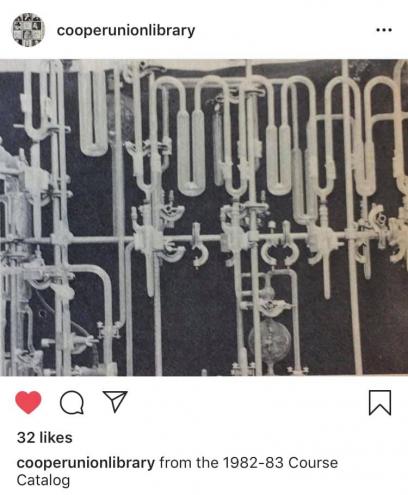
Current Full-time Faculty of the Chemistry Department
- Fabiola Barrios-Landeros, Assistant Professor of Chemistry [2020-present]. B.S. Natl. Auton. Univ. Mexico (UNAM); M.S., Ph.D. Yale University.
- Andrea Newmark, Professor of Chemistry, and Chair, Department of Chemistry [1987-present]. B.A. Queens College; M.S., Ph.D., Columbia. See http://pioneer.cooper.edu/2013/11/02/faces-cooper-andrea-newmark/ Prof. Newmark is the first woman to earn tenure within the School of Engineering, and is the first woman to chair one of its departments (Chemistry).
- Ruben Savizky (Chem Eng 1998), Associate Dean of Engineering, and Professor of Chemistry [2005-present]. Ph.D. Yale. Prof. Savizky is the first person of Hispanic heritage to earn tenure within the School of Engineering, and the first such to serve as Associate Dean of Engineering.
- Robert Q. Topper, Professor of Chemistry [1993-2003; 2009-present] B.S. Florida State; M.S., M.Phil.,Ph.D., Yale. See http://pioneer.cooper.edu/2015/03/08/faces-cooper-robert-topper/ .
Current Full-time Faculty of the Chemical Engineering Department
- Benjamin J. Davis, Professor of Chemical Engineering and Chair, Department of Chemical Engineering [2009-present]. B.S. Cornell; Ph.D. UCLA.
- Ogbonnaya Charles Okorafor, Professor of Chemical Engineering, Department of Chemical Engineering [19XX-present]. B.Sc., U Lagos (1977); M.A.Sc. (1980), Ph.D. (1982), U British Columbia. [55] Prof. Okorafor is the first African-American person to earn tenure within the School of Engineering, and was the first to chair one of its departments (Chemical Engineering).
- Amanda Simson, Assistant Professor of Chemical Engineering [2017-present]. B.Eng. U Virginia; Ph.D. Columbia.
- Jennifer Weiser, Associate Professor of Chemical Engineering [2017-present]. B.S. Rensselaer Poly; M.S., Ph.D. Cornell. See http://pioneer.cooper.edu/2017/10/02/faces-cooper-jennifer-weiser/
Current Adjunct Faculty in Chemistry and Chemical Engineering (2022-2023) (this list is not complete)
- Peter Bastos, Adjunct Professor of Chemistry. [2004 - present]. B.S. Rutgers U.; M.S. Stevens Inst. of Tech.; Ph.D. U of Nijmegen, Holland.
- Kevin S. Kolack, Adjunct Professor of Chemistry [1998 - present]. B.S. U of Virginia 1991; Ph.D. Indiana U 1997.
Technicans and Staff (2023-2024)
- Khemet Calnek, Chemistry and Chemical Engineering Laboratory Technician
- Revans Ragbir, Chemistry Laboratory Technician
Chemistry Faculty: A Historical List
The following is a list of full-time, tenure-track faculty who have served the Chemistry Department in the past, or who held a title such as "Professor of Chemistry." Current faculty are not included in this list. Years of service follow each person's title in brackets, where known.
- John L. Bove', Professor Emeritus of Chemistry and Environmental Engineering [1958-2011] (b.4/3/1928; d.3/3/2022). B.A., M.S. Bucknell Univ.; Ph.D. Case-Western Reserve University. (Served as Chair of Chemistry, 1990-2010)
- Horace G. Byers, Professor Emeritus of Chemistry (Served as Department Head during 1920s; joined CU sometime after WWI) (b.1872; d.1956) [2,6] https://pubs.acs.org/doi/abs/10.1021/cen-v034n051.p6205
- Henry Cornelius Enders (Chemistry 19??). Associate Professor of Chemistry [early 20th c.-1920?]. (d. April 1, 1948). B.S. Cooper Union (Chemistry); M.S. Columbia University. [26]
- Julius "Jack" Klerer, Professor Emeritus of Chemistry (b. 1928; d. 1996). B.A., M.S., Ph.D., New York University. Served as Acting Dean of the short-lived School of Liberal Arts and Sciences. Also worked at Bell Labs. [17,29,30]
- Robert Spice, Professor Emeritus of Chemistry [1884-1914]. Served as Chair of Chemistry (1900-1914). [32]
- Charles S. Stone, A.M., Professor of Chemistry and the first Cooper Union Chemistry Laboratory Director. [13]
- James Coull, Assistant Professor of Chemistry [1930s-]. B.Sc.; A.M.; Ph.D. (institutions unknown)
- John C. Draper, Professor of Chemistry [1859]. (March 31, 1835 – December 20, 1885) Chemist, physician, professor at NYU amd City College. B.S. NYU, MD (institution unknown). Son of John William Draper, founder of the American Chemical Society, and Antonia C. dP.P. Gardner, personal physician to John VI of Portugal.
- Zvi C. Koren (formerly Kornblum), Professor of Chemistry [1977-1991]. B.S. Brooklyn College, Ph.D., City University of New York. Served as Chair of Chemistry (1989). Subsequently worked at Shenkar College of Engineering, Design * Art in Ramat-Gan, Israel as Director of the Edelstein Center for the Analysis of Ancient Artifacts.
- Rebecca A. LaRue, Associate Professor of Chemistry. [19XX-2001]. Ph.D., Univ. of Cincinnati.
- Marcus Lay, Associate Professor of Chemistry. [2014-2019]. Ph.D. U. Georgia. See http://pioneer.cooper.edu/2014/12/03/faces-cooper-marcus-lay/
- John C. Olsen*, Professor of Chemistry [?-1918]. Came to Cooper Union from Brooklyn Polytechnic Institute; returned there in 1918 to "take charge of the newly created department of Chemical Engineering." [36], [56]
- Clarence S. Sherman, Professor of Chemistry [started sometime prior to 1953]. Sc.B., Sc.M., Ph.D. Brown University. [43] [60]
Chemical Engineering Faculty: A Historical List
The following is a list of full-time faculty who have served the Chemical Engineering Department in the past, or who held a title as "Professor of Chemical Engineering." Current faculty are not included in this list. Includes faculty who were "Professor of Metallurgy" within the ChemE department.
- Zikri M. Ahmed, Professor of Chemical Engineering [1988-2008]; (1/1/1941-2008). B.Sc., Cairo Univ. (1966); M.S.,Ph.D., New Jersey Institute of Technology (1973 and 1981). [12] [54]
- Irving Brazinsky (Chem Eng 1958), Professor Emeritus of Chemical Engineering [1985 - 2016] (b 10/27/36; d. 4/14/2022).[56] B.Ch.E. Cooper Union (1958). M.S. Lehigh Univ., Sc.D. Mass. Inst. of Tech. (Served as Chair of Chemical Engineering). See http://pioneer.cooper.edu/2014/02/24/faces-cooper-irv-brazinsky/ and https://cooper.edu/engineering/news/remembrance-irving-irv-brazinsky-che58 .
- Shang-I ("S-I") Cheng, Professor Emeritus of Chemical Engineering [19XX-1992] (b. 06/05/1920; d. 03/18/2017). B.S., National Chekiang Univ.; M.S., Ph.D. University of Florida. (Served as Chair of Chemical Engineering.)See https://www.findagrave.com/memorial/195049658/shang-i-cheng
- Edward F. Ferrand, Jr., Associate Professor of Chemical Engineering [approx.1952-1972]. B.S. St. Johns U; graduate degrees unknown. Later served as the Director of the Science and Technology Bureau for the New York City Dept. of Environmental Protection until retirement. See https://www.legacy.com/us/obituaries/nytimes/name/edward-ferrand-obituary?id=29081698
- Robert S. Kapner, Professor Emeritus of Chemical Engineering. B.Ch.E. Polytechnic Institute of New York (1950); M.S., University of Cincinnati (1952); D.E., Johns Hopkins University (1960). [51]
- Herbert Liebeskind, Professor Emeritus of Chemical Engineering [1945-1987] (d. April 1, 1996). B.S., New York University. [4]
- Daniel H. Lepek (Chem Eng 2004), Professor of Chemical Engineering [2009-2023]. (d. 5/26/2023)
- Albert Broadus Newman, Professor Emeritus of Chemical Engineering [1929-?]. First chair of the renamed Chemical Engineering department. Ph.D. (1928) Univ of Michigan. [33]
- Arthur H. Radasch, Professor Emeritus of Chemical Engineering [1938-1963] (b. 1887; d. Feb 23, 1975). B.S. Mass. Inst. Tech. (1920). Previously taught at Alfred Univ. and worked at R&D dvision of Barrett Co. (1927-1938). Held patents on methods for coal-tar distillation. [7]
- Richard J. Stock, Professor Emeritus of Chemical Engineering [1994-2019]. Served as Chair of Chemical Eng and as Acting Dean of Engineering. B. Sc. University of Nottingham, Ph.D. West Virginia University.
- Milada Alberts, Assistant Professor of Chemical Engineering [1981-X]. M.S. Institute of Chemical Technology, Prague; Ph.D., Czechoslovakian Academy of Sciences, Prague.
- George T. Chang, Professor of Chemical Engineering [1968-1987]. B.Eng. National Taiwan University; Ph.D. Rice University (1966). [28]
- Caleb K. Charny, Assistant Professor of Chemical Engineering [1989-1991]. B.S.,SUNY-Buffalo (1983); Ph.D., Johns Hopkins University (1988); M.D., New York University School of Medicine and New York Hospital Medical Center-Cornell Medical Center (2000).
- Marca Lam (Anderson), Associate Professor of Chemical Engineering [1999-2006]. B. S., M.S., SUNY-Buffalo; Ph.D., Virginia Polytechnic Inst. Senior Lecturer, Rochester Inst. Tech. (2006-present)
- Chongkit Laohaku, Assistant Professor of Chemical Engineering [1982-?]. B.Sc. University of Sydney; B.Sc. Imperial College; Ph.D. University of Cambridge.
- J. Merriam Peterson, Professor of Chemical Engineering [started before 1953]. B.S., M.S., Iowa State U; Ph.D. U of Illinois. Director, "Green Engineering Camp".[60?]
- Allen L. Rakow, Associate Professor of Chemical Engineering [1975-81] (b. Nov 16, 1943; d. 1999); B.Ch.E. Rensselaer Polytechnic Institute; M.Ch.E. Stevens Institute of Technology; D.Sc. Washington University. Assoc. Professor, New Mexico State U (1981-1990).; Assoc. Professor, Colorado State U (1990-1999). [52,53]
- George Sidebotham, Professor of Mechanical Engineering; Associate Professor of Chemical Engineering [Chem E. 1989-2003; Mech E. 2003-present]. B.S. Trinity College; M.A., Ph.D. Princeton.
- Leonard Wender, Assistant Professor of Chemical Engineering [1953] B.Ch.E. City College NY; S.M., Mass. Inst. of Tech. (later became a part-time instructor)
- Norman E. Woldman, Associate Professor of Metallurgy [1953] B.S. Case Inst. Tech; M.S. Ohio State U; Ph.D. Columbia U.
Instructors: A Historical List
This faculty rank no longer exists at Cooper Union. It seems to have been mostly used for full-time faculty who taught within the school but did not hold a doctorate in their field of expertise, but was also used for certain part-time faculty. In the modern era virtually all chem/ChemE faculty hold a doctorate.
- Joseph Allerton, Instructor in Chemistry [5]
- Alfred R. Bayer,* Instructor in Chemistry. (b March 12, 1910; d. April 7, 2002). B.Ch.E. Rensselaer Polytechnic Inst.; M.S. (Chemistry), Lafayette College (1933). Chief Engineer, Brooklyn Union Gas Co., for 30+ years; consultant. Also taught at the University of Algiers (Algeria). [5]
- Henry A. Birdsall, Instructor in Chemistry [5]
- Temple Clayton, Instructor in Chemistry. B. Chem., Cornell Univ. (1935); M.S., Columbia (1941). Research chemist in the Steroid group of the Research division of Schedring Corp. (Bloomfield, NJ). Also taught at Newark College of Engineering (which is now called NJIT).[5,41]
- Donald W. Deed, Instructor in Chemical Engineering [5,42].
- Frank R. Forrester, Instructor in Chemistry [5]
- Victor Franceschini, Instructor in Metallurgy [1954]. B.S.
- Henry B. Hope, Instructor of Analytical Chemistry. B.Ch.E., A.M. (institutions unknown) [3]. Taught at Cooper Union from 1920s to 1967.
- Herman Horn, Instructor in Chemistry. [1956] B.S., Brooklyn College.
- Raymond J. Kuntz, Instructor of Chemical Engineering [1930s]. B.S., Ch.E.[5]
- Saul R. Locke, Instructor in Metallurgy [1954]. B.S. U Kentucky, M.S. Polytech Inst. Brooklyn.
- August Mendizza, Instructor in Chemical Engineering [5]
- John D. Oathout, Instructor in Chemical Engineering [5]
- Fred J. Roeben, Instructor in Chemistry [5]
- Charles F. Stolzenbach, Instructor in Chemistry. B.Chem Eng., Cooper Union (1931); M.S., Columbia Univ. (1932).[5,44]
- Maximilian Toch (Chemistry 1884+) Instructor of Applied Chemistry. Earned one of the first Certificates in Chemistry in 1884; coordinated the 1920 degree in Applied Chemistry. [2]
- Norman M. Trieff, Instructor in Chemistry [1955]. B.S. Polytech Inst of Brooklyn; M.S. State U of Iowa.
- William J. Wiswesser,* Instructor in Chemistry [during the early 40s] (b. 1914; d. 12/1989) [5,45]. B.S. (1936), Ph.D., Lehigh Univ. (1974) (Chemistry). Inventor of the Wiswesser line notation (WLN).[46] Wrote or co-authored more than 50 papers. Also worked at Hercules Research Station (Wilminton, DE); Trojan Powder Co. (Allentown); Willson Products (1945-1963); U.S. Army, Fort Detrick / Edgewood Arsenal (1963-). Numerous awards and honors, including the Herman Skolink Award of the ACS Division of Chemical Information and the U.S. Army Exceptional Service Award. [46]
- Hector Zucchino (1953) Instructor of Chemistry. B.Ch.E. (institution unknown)
Adjunct Faculty: A Historical List
The faculty listed below have taught extensively in the Chemistry and Chemical Engineering departments in previous years but are not active in the present academic year. Work in progress.
- G.V. Chandrashekhar, Adjunct Professor of Chemistry (later 1990s - mid 2000s). B.Sc., M.Sc., Univ. of Mysore; Ph.D., Indian Institute of Technology. "Chandra" did important work on high-tempeature superconductor research during his time with IBM's T.J. Watson Research Center.
- Yanir Maidenberg (Chem Eng 2005), Adjunct Professor of Chemical Engineering. B.Ch.E. Cooper Union; M.S., Ph.D., Columbia Univ.(2011,2013). Currently at NYU-Tandon School of Engineering.
- Albert Reis (Chem Eng 1977), Adjunct Professor of Chemical Engineering. B.Eng., Cooper Union (1977).[5]
- James Rubenstone, Adjunct Professor of Chemistry.
- Behrooz Satvat, Adjunct Professor of Chemical Engineering (1980s?)
- Omar A. Sharafeddin, Adjunct Professor of Chemistry [1997-2017]. B.S. Baylor Univ; Ph.D. Univ. of Houston.
- Susan T. Silk, Adjunct Professor of Chemistry. B.Ch.E., City College of New York; Ph.D., New York University.
- Samuel Wiener, Adjunct Professor of Chemistry [2003-2021].
Faculty Memories
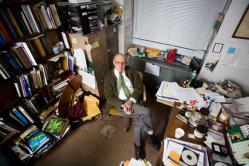 Perhaps no faculty member left more of a mark on the Chemistry Department, or on Cooper Union, in the 20th century than Prof. John Bove'. In this image he is pictured in his office at 51 Astor Place, shortly before the building was demolished and the School of Engineering moved to its present home at 41 Cooper Square. Bove' was an expert in organic chemistry and environmental engineering. He taught general, organic and analytical chemistry to generations of students, usually without the use of lecture notes. Bove' served from 1958 to 2011 (with a short break in the middle) and mentored countless research students and faculty members with wit and charm. He passed away in 202, but his legacy lives on.
Perhaps no faculty member left more of a mark on the Chemistry Department, or on Cooper Union, in the 20th century than Prof. John Bove'. In this image he is pictured in his office at 51 Astor Place, shortly before the building was demolished and the School of Engineering moved to its present home at 41 Cooper Square. Bove' was an expert in organic chemistry and environmental engineering. He taught general, organic and analytical chemistry to generations of students, usually without the use of lecture notes. Bove' served from 1958 to 2011 (with a short break in the middle) and mentored countless research students and faculty members with wit and charm. He passed away in 202, but his legacy lives on.
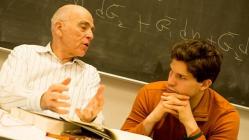 Professor Irv Brazinsky (ChE 1958), longtime chair of the Chemical Engineering department, is shown sharing his expertise in chemical thermodynamics with a student (with the Gibbs-Duhem equation displayed behind them). Brazinsky was an enthusiastic alumnus of Cooper Union. His leadership and character were admired and emulated by his students and his colleagues in the School of Engineering and the Chemical Engineering and Chemistry departments. Irv also passed away in 2022; he and John Bove' were close friends and colleagues.
Professor Irv Brazinsky (ChE 1958), longtime chair of the Chemical Engineering department, is shown sharing his expertise in chemical thermodynamics with a student (with the Gibbs-Duhem equation displayed behind them). Brazinsky was an enthusiastic alumnus of Cooper Union. His leadership and character were admired and emulated by his students and his colleagues in the School of Engineering and the Chemical Engineering and Chemistry departments. Irv also passed away in 2022; he and John Bove' were close friends and colleagues.
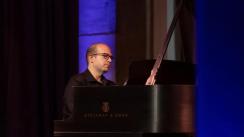 We lost Professor Daniel Lepek (ChE 2007) to cancer in May 2023. Our hearts are still heavy. In addition to his many academic accomplishments and contributions, he was a wonderful pianist, composer and conductor who especially loved the theater. Cooper Union was his favorite place to be. We all miss him terribly.
We lost Professor Daniel Lepek (ChE 2007) to cancer in May 2023. Our hearts are still heavy. In addition to his many academic accomplishments and contributions, he was a wonderful pianist, composer and conductor who especially loved the theater. Cooper Union was his favorite place to be. We all miss him terribly.
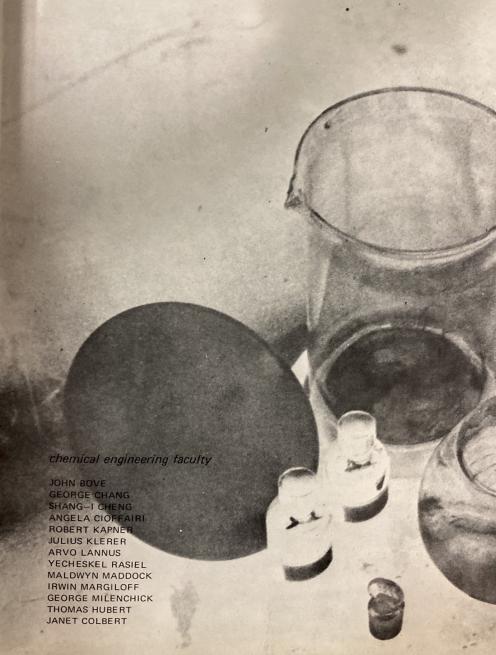
This image from the 1973 Cable (Cooper Union's yearbook) shows all of the chemistry and chemical engineering faculty listed within the Chemical Engineering department. The other departments were MechE, CivilE, ElecE, Math and Physics.
Acknowledgments
I am very grateful to the Cooper Union library, which gave me full access to Cooper Union's course catalog archives and created an invaluable online archive of annual Trustees Reports. The University of Illinois library system used Google Books to archive the Trustees Reports which cover the period of transition from Chemistry to Industrial Chemistry to Chemical Engineering at Cooper Union, which were extremely helpful as well. Mary K. Lynch was kind enough to provide helpful information regarding the Chemical Engineering faculty during the 1980s, and Prof. Andrea Newmark assisted me with her own memories and references.
References
[1] http://library.cooper.edu/archive/annual_reports/1859-1860%20Annual%20Report%20Part%201.pdf
[2] See Journal of Industrial and Engineering Chemistry, Vol. 12, No. 6, pp. 611-612 (June 1, 1920). https://pubs.acs.org/doi/10.1021/ie50126a601
[3] http://pubs.acs.org/doi/abs/10.1021/cen-v028n022.p1865
[4] http://prabook.com/web/person-view.html?profileId=815528
[5] http://cooper.libguides.com/FAEngHonorSoc
[6] http://academictree.org/chemistry/peopleinfo.php?pid=52502&expand=bio
[7] The New York Times, Feb. 24, 1975, p. 24. Accessed 1/10/2017. http://www.nytimes.com/1975/02/24/archives/arthur-radasch-chemist-taught-at-cooper-union.html?_r=0
[8] R. Conot, Thomas A. Edison: A Streak of Luck (Da Capo Press, New York, 1979).
[9] Cooper Union Graduation Program, 1927 (Viewed in the Cooper Union Archives on 1/17/2017).
[10] Victor Gustav Bloede (chemist), https://en.wikipedia.org/wiki/Victor_Gustav_Bloede_(chemist). Accessed 9/6/2018.
[11] N.A. Peppas, The First Century of Chemical Engineering, in Distillations, published by the Science History Institute, Fall 2008. https://www.sciencehistory.org/distillations/magazine/the-first-century-of-chemical-engineering
[12] "In Memoriam: Zikri Ahmed", At Cooper Union, p.34, Summer 2008.
[13] 25th Annual Report of the Trustees of the Cooper Union for the Advancement of Science and Art, May 28th, 1884. Accessed 2/6/2019.
[14] 24th Annual Report of the Trustees of the Cooper Union for the Advancement of Science and Art, May 26th, 1883. Accessed 2/6/2019.
[15] E.C. Mack, Peter Cooper: Citizen of New York (Duell, Sloan and Pearce, New York, 1949). See p. 269.
[16] P. Buckley, The Cooper Union for the Advancement of Science and Art - Chonology (1997; revised by M. Brooks and C. Salomon, 2008).
[17] Decisions of the National Labor Relations Board, Case 2-CA-17483,p. 1768 (5 February 1985).
[18] "Peter Cooper: Jell-O", Lemelson-MIT Program, https://lemelson.mit.edu/resources/peter-cooper . Accessed 4/8/2019.
[19] Note: Edison is included because he only took courses in chemistry at Cooper Union, in order to help him design an improved electrical stylus. See References 8 and 22.
[20] https://www.nytimes.com/1992/07/30/nyregion/albert-nerken-79-an-engineer-industrialist-and-philanthropist.html . Accessed 4/8/2019.
[21] "Victor Gustav Bloede", Immigrant Entrepreneurship: German-American Business Biogaphies, https://www.immigrantentrepreneurship.org/entry.php?rec=132 . Accessed 4/15/2019.
[22] "Thomas Edison, Chemist: National Historic Chemical Landmark," American Chemical Society, https://www.acs.org/content/acs/en/education/whatischemistry/landmarks/thomas-edison.html . Accessed 4/15/2019.
[23] Topper, Robert. "Thomas Edison, Chemistry and Cooper Union" on the Cooper Union website, http://faculty.cooper.edu/topper/general/edison.html . Accessed 4/15/2019.
[24] "Dr. Michael Kasha," Florida State University Institute of Molecular Biophysics, http://biophysics.fsu.edu/michael-kasha/ . Accessed 4/15/2019.
[25] "Alumni Profile: Jackie Ying, ChE 87," http://cooperalumni.org/alumni-profile-jackie-ying-che87/. Accessed 4/15/2019.
[26] "Henry C. Enders," The New York Times, April 2, 1948. Accessed 4/20/2019. (See below). Notably, Prof. Enders endowed the Enders Fund to support Cooper Union chemistry students wishing to pursue graduate work.
[27] "John L. Smith", in "The Team that Forever Changed Baseball and America: The 1947 Brooklyn Dodgers," Society for American Baseball Research (2012). See also https://sabr.org/bioproj/person/2e658a3e .
[28] "Taiwan's Struggle: Voices of the Taiwanese,"edited by Shyu-tu Lee and Jack F. Williams, Rowman & Littlefield, Lanham, MD (2014). See p. 53. Prof. Chung is also known as Chang Chan-hung.
[29] See http://library.cooper.edu/tf/mission-vision_1988-2015.pdf. Accessed 5/1/2019.
[30] See https://edelsteincenter.wordpress.com/articles/general-chemistry/. Accessed 5/1/2019.
[31] See https://www.bumc.bu.edu/biochemistry/profiles/elizabeth-simons/ . Accessed 5/1/2019.
[32] Nature, Volume 93, 1914. Accessed 5/1/2019.
[33] See http://umhistory.s3-website.us-east-2.amazonaws.com/Chemical_Engineering_files/*Wilkes%20Chemical%20Engineering%20History%20copy.pdf . Accessed 5/1/2019.
[34] See http://www.legacy.com/obituaries/bostonglobe/obituary.aspx?n=elizabeth-reiman-simons&pid=192300514 . Accessed 5/1/2019.
[35] See https://prabook.com/web/elizabeth_reiman.simons/1443537 . Accessed 5/1/2019.
[36] 59th Annual Report of the Trustees of the Cooper Union for the Advancement of Science and Art (July 1, 1918). Accessed via Google Books on 6/9/2019.
[37] 62nd Annual Report of the Trustees of the Cooper Union for the Advancement of Science and Art (July 1, 1921). Accessed via Google Books on 6/9/2019.
[38] 65th Annual Report of the Trustees of the Cooper Union for the Advancement of Science and Art (July 1, 1924). Accessed via Google Books on 6/9/2019.
[39] 66th and 67th Annual Reports of the Trustees of the Cooper Union for the Advancement of Science and Art (July 1, 1926). Accessed via Google Books on 6/9/2019.
[40] Since both the Day School and Night School offered only courses in civil, chemical, electrical, and mechanical engineering in 1926, the different names seem less appropriate to the modern reader.
[41] B. Whitman and T. Clayton,"Identification of Unknown Substances," in Punched Cards: Their Applications to Science and Industry, edited by Robert S. Casey & James Whitnet Perry (1951). Accessed via Google Books on 6/9/2019.
[42] B.L. Lerner and C.S. Grove, Ind. Eng. Chem. 1951, 43, 1, 216-225. See Acknowledgements. DOI: https://doi.org/10.1021/ie50493a054 .
[43] C.S. Sherman and R. Herzog, Ind. Eng. Chem. 1940, 12,3, 136-137. DOI: https://doi.org/10.1021/ac50143a004 .
[44] Columbia University Catalogue for the Sessions of 1935-1935. Accessed 6/9/2019.
[45] "William J. Wiswesser, 75, Distinguished Berks Chemist," The Morning Call, 12/19/1989.
[46] "Wiswesser line notation," Wikipedia. URL: https://en.wikipedia.org/wiki/Wiswesser_line_notation. Accessed 6/9/2019.
[47] D.R. Raichel, New Jersey's Union College: A History, 1933-1983. URL: https://books.google.com/books?id=Ih-diCL16ioC&pg=PA126&lpg=PA126&dq=Elmer+J.+Badin+cooper+union&source=bl&ots=0KZix-5BZG&sig=ACfU3U1ofjfL90rUS1Hi2BblMWkp1-GoDQ&hl=en&sa=X&ved=2ahUKEwiaidaajLTpAhVTmHIEHXYKDFgQ6AEwAXoECAoQAQ#v=onepage&q=Elmer%20J.%20Badin%20cooper%20union&f=false . Accessed 5/14/2020.
[48] Elmer J. Badin and Melvin Calvin, The Path of Carbon in Photosynthesis. IX. Photosynthesis, Photoreduction and the Hydrogen—Oxygen—Carbon Dioxide Dark Reaction, Journal of the American Chemical Society 1950 72 (11), 5266-5270. DOI: 10.1021/ja01167a134 .
[49] Elmer J. Badin (1917-1999). URL https://www.ancientfaces.com/person/elmer-j-badin-birth-1917-death-1999/18285799. Accessed 5/14/2020.
[50] Elmer J. Badin, David R. Walters, and Robert N. Pease, The Ignition of n-Butane by the Spontaneous Oxidation of Zinc Dimethyl, Journal of the American Chemical Society 1947 69 (11), 2586-2588. DOI: 10.1021/ja01203a006 .
[51] "Conferring of Degrees at the close of the eight-fourth academic year," The Johns Hopkins University, June 14, 1960. See "Doctors of Engineering with titles of dissertations," Robert Sidney Kapner. https://jscholarship.library.jhu.edu/bitstream/handle/1774.2/36815/commencement1960.pdf
[52] N. Rakow, private communication (2020).
[53] Allen Leslie Rakow, https://prabook.com/web/allen_leslie.rakow/824156. Accessed October 19, 2020.
[54] Zikri Mostafa Ahmed, https://prabook.com/web/zikri_mostafa.ahmed/835461/ Accessed December 15, 2020.
[55] "The Development of Appropriate Chemical Engineering Education for Nigeria," O.C. Okorafor, Chemical Engineering Education 21(2), 102 (1987).
Last edited July 11, 2023.

